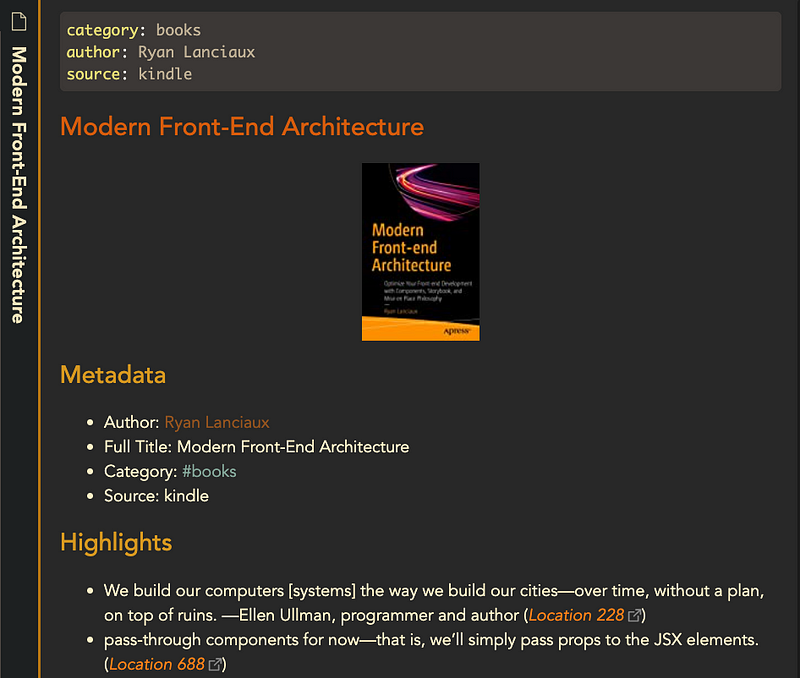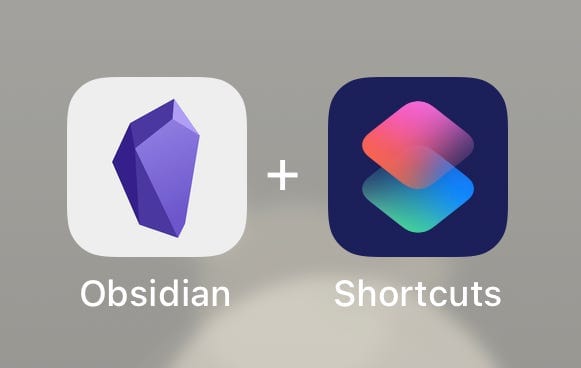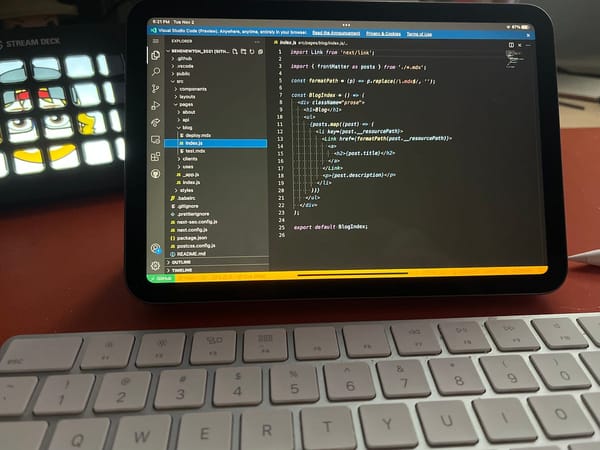First Look at the Official Readwise Obsidian Plugin
A rundown of the official Obsidian plugin from Readwise

Readwise has released an official plugin to import your Readwise data into Obsidian. If you’re not using Readwise yet, it’s worth a look. Readwise is one of my favorite iOS apps to come out in a long time. I use it every day. So the possibility of automating the importing of that data into my daily note-taking regimen is big.
What is Readwise?
Simply put, it aggregates all your highlights from your Kindle library, Pocket, Medium, Instapaper, tweets, or even the web, then feeds them back to you in a daily email digest or you can cycle through random highlights via the app. This helps you remember what you read by resurfacing the highlights again and again. Checking my highlights daily is one of the only streaks I have kept out of everything I try to track.
With this new plugin, you can continuously bring in your latest highlights, along with the metadata for books, or articles, or tweets from your Readwise account into Obsidian. From there, you can incorporate the notes into your note-taking workflow.
Plugin Settings
The plugin is available soon in the community plugin section of Obsidian by searching for Readwise Official.
Let’s dive in and take a closer look at the available settings in the Obsidian App for this plugin.

Sync Readwise data with Obsidian
With this button, you can trigger a sync of your Readwise highlights any time you need to if you don’t set it to do so automatically.
Customize formatting options
This opens up the Obsidian Export section of your Eadwise account on their site. Here there are three different settings available.

Group Files in Category Folders
The first option in settings is for setting the structure of how your files get saved. Obsidian will import highlights into a folder structure by category, books, articles, or tweets if enabled. If left disabled, Obsidian will keep your notes in a flat-file arrangement which many users prefer.
Use Custom Formatting
The following section is where most of the new functionality comes compared to currently available unofficial Readwise community plugins. When enabled, you can customize the output of your notes from Readwise in the Obsidian Export section of their site. Here, you can customize the file’s output with many variables and conditions with all the examples you could want.
They have laid these out as separate inputs. The first is a text input for the title. Unfortunately, it is not a text area, so you are limited to a single line. However, having this input as the first line of the file eliminates the opportunity to add YAML front matter, which is one of my only suggestions so far.
UPDATE: They added front matter — see below
Here are the sections you can customize to build your note for export:
Title

Metadata

The second text box is metadata. This section is the body of the note before the highlights. Unlike the first input, this is a multiline text area. Here you can add multiple fields to the note. One of the fields I’m happy to see here is the cover image. I have only seen this in the import markdown option for Readwise previous to this plugin. You can also use inline code to include the cover image as well as anything else conditionally. So if there’s no image, the exported no will not contain the line.
Fields available:
- title
- full_title
- author
- URL
- category
- image_url
- date
- time
- source
Highlights Header

This section, as you’d expect, is the header for the highlights section. However, there are some valuable variables you can use conditionally to customize your header. For example, if this is an existing note that you are importing new highlights into, you can customize the section header or simply not show it.
Fields available:
- is_new_page
- has_new_highlights
- date
- time
Highlight

In this last section of the template, you can customize the highlight itself. Along with the highlight, you get access to the tags and notes added to the highlight.
Fields available:
- highlight_text
- highlight_location
- highlight_location_url
- highlight_tags
- highlight_note
YAML Front Matter (Updated)
This section was added Monday morning after I published this post. The great developers over at Readwise heard our suggestions and added them almost immeditely. Shows they care about what their users want.

Now you can add front matter to your exported notes as well. This will allow you to use the Dataview plugin to perform some complex queries and makes the notes more valuable to your overall workflow.
Fields available:
- title
- full_title
- author
- URL
- category
- image_url
- date
- time
- source
Sync Notification (Log) file

In this section, you can customize a log file of all your synch data for each time there is a sync.
Fields available:
- date
- time
- num_highlights
- num_books
You can customize dates in any of these sections. There is a link to documentation on the page.
I haven’t made many changes to the values passed to the note out of the box except for adding hashtags to the highlight tags. However, I am sure as time passes, I will discover more changes to make.
I’m hoping for some changes in future releases, like the ability to turn off their customization altogether and use an Obsidian template instead would be an excellent option. If you’re using the Templater plugin, I discovered that you can pass Templater strings from their configuration page, rendering as expected in the imported note.
Select Items to be Exported

This last setting allows you to customize what to export from Readwise.
There’s a drop-down to choose content a few different ways:
- All
- None
- Highlighted in the past week only
- Highlighted in the past month only
- 10 most recently highlighted items
- 100 most recently highlighted items
Below that, there’s a list of all your books, articles, and tweets. It includes the name, author, and the number of highlights. From there, you can enable/disable syncing from individual books and refresh any book in Obsidian. The sync will happen on the next sync run from Obsidian, and there’s a warning that if you do not delete the initial note, you will end up with a duplicate note appended to the original. However, I have found just deleting a note will replace it on the next sync as well.
Customize Base Folder
This setting is where Obsidian will save your notes in your vault. By default, it will use a folder named Readwise.
Configure Resync Frequency
Options:
- Manually
- Every Hour
- Every 12 Hours
- Every 24 Hours
If this is not set to manual, it will sync when Obsidian is opened and at the selected interval for as long as the app is open.
Sync Automatically when Obsidian is Opened
As it says, if the setting is enabled, it will sync with Readwise when the app opens. I assume this is only needed if you have the frequency set to manual.
Examples
Here’s an out of the box synced note with no customization:

Here’s a note with an additional Highlight added:

You can see additional highlights are added with the new header if you configure it. This setting allows the note to grow with some context to time. For example, in this screenshot, you can see tags and notes included with the highlights.
How Will I Use This? Readwise Integration Ideas
I’m looking forward to integrating these notes into my note-taking and writing. I am going to look into different possibilities using Dataview in other notes to query these. Once I figure out some uses, I will share them in a new write-up.
Overall I think this is an excellent plugin for an initial release. It appears Readwise has allowed access to all possible data they have, making the possible uses great. As more of us dig into this further, I’m sure we will have more requests for features, and they appear willing to listen, so I expect this to continue to evolve.
Once I figure out some of the possibilities of incorporating this into my daily note-taking, this will become even more important to my routine. But, for now, I expect this to be a place where I can link to highlights and maybe use them when necessary without going to Readwise to search.
Let me know how you will use this plugin. If you’re not using Readwise, I suggest you download it and at least use it for the trial.
Get a free month of Readwise by using this link. https://readwise.io/i/ben203




